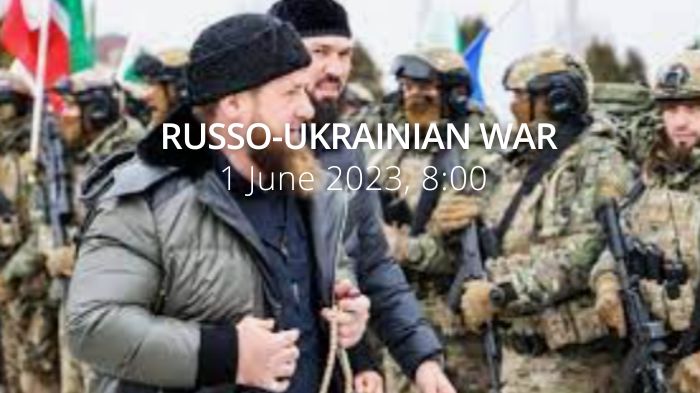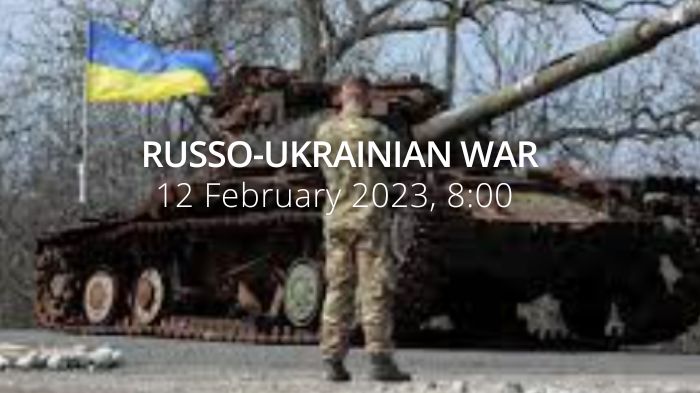Russian troops launched 7 missile and 32 air strikes, and launched more than 70 MLRS attacks, damaging more than 35 settlements of the Sumy, Kharkiv, Luhansk, Donetsk, Zaporizhzhia, Kherson and Mykolaiv Oblasts. Russian units were defeated in Zaporizhzhia Oblast. Ukrainian forces likely made marginal gains in Luhansk Oblast and intensified offensive operations toward Kreminna. Russian forces continued offensive operations in Donetsk Oblast. Russia is preparing a multi-layered defense on the east bank of the Dnipro river in the southern Kherson Oblast. Russian occupation authorities in Kherson Oblast force residents out of the western part of the oblast by cutting communications. Russian National Security Council Secretary Patrushev arrived in Tehran to discuss the potential sale of Iranian ballistic missiles to Russia. Ukraine to submit a draft resolution to UN to force Russia to pay reparations,
Daily overview — Summary report, November 9
A map of the approximate situation on the ground in Ukraine as of 00:00 UTC 09/11/22. pic.twitter.com/IB1AySNImV
— War Mapper (@War_Mapper) November 9, 2022
The General Staff’s operational update regarding the Russian invasion as of 06.00 am, November 9, 2022 is in the dropdown menu below:
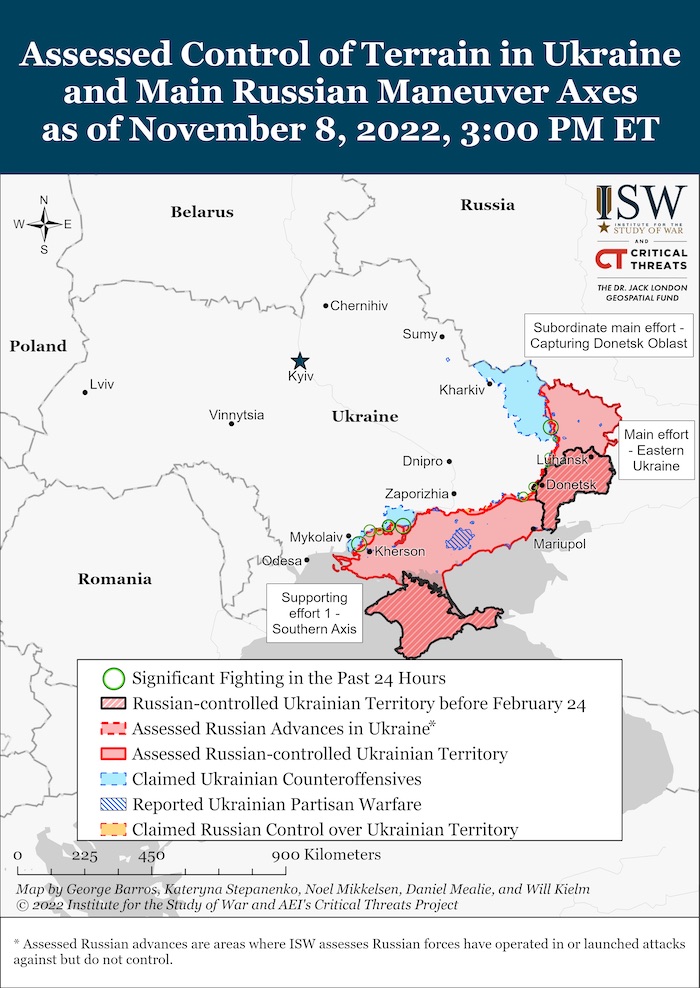
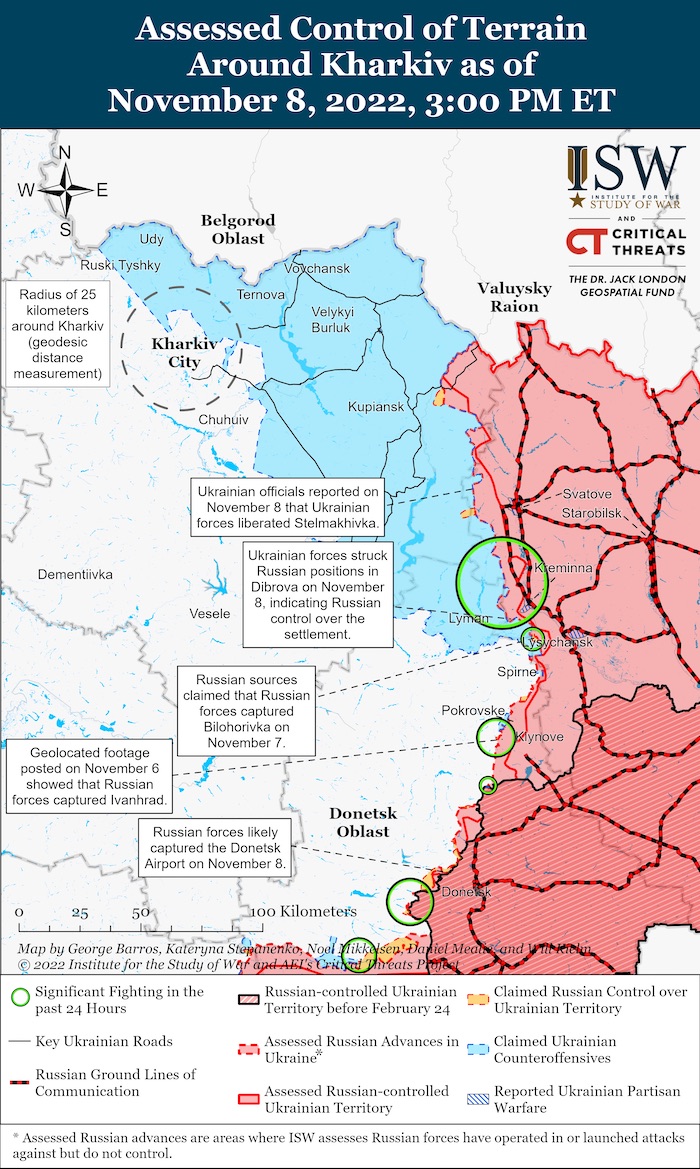
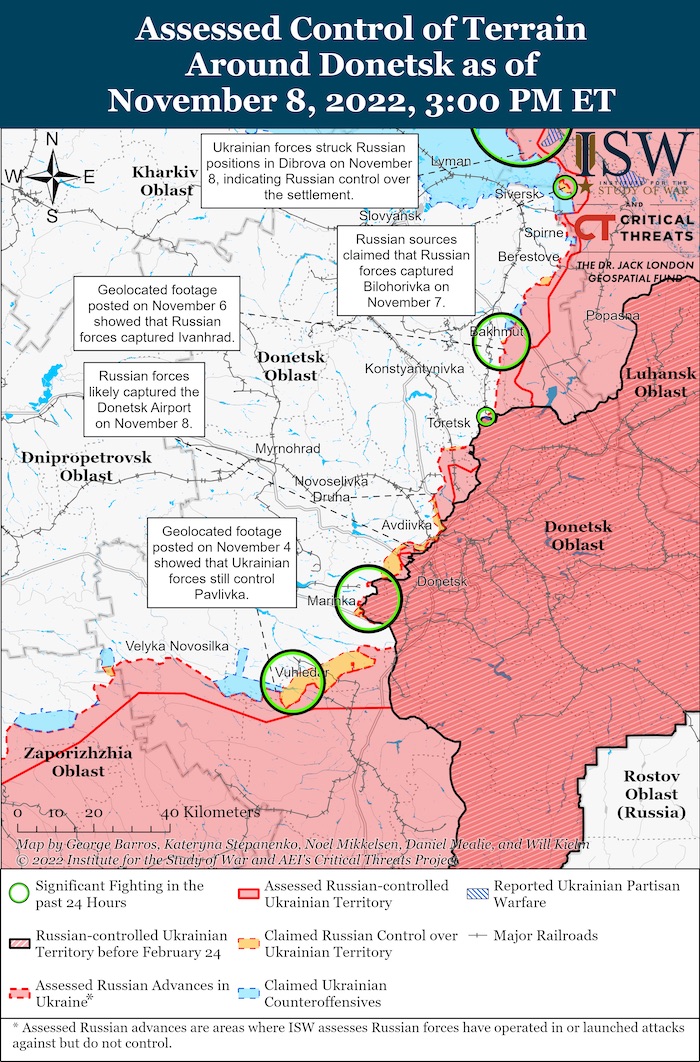
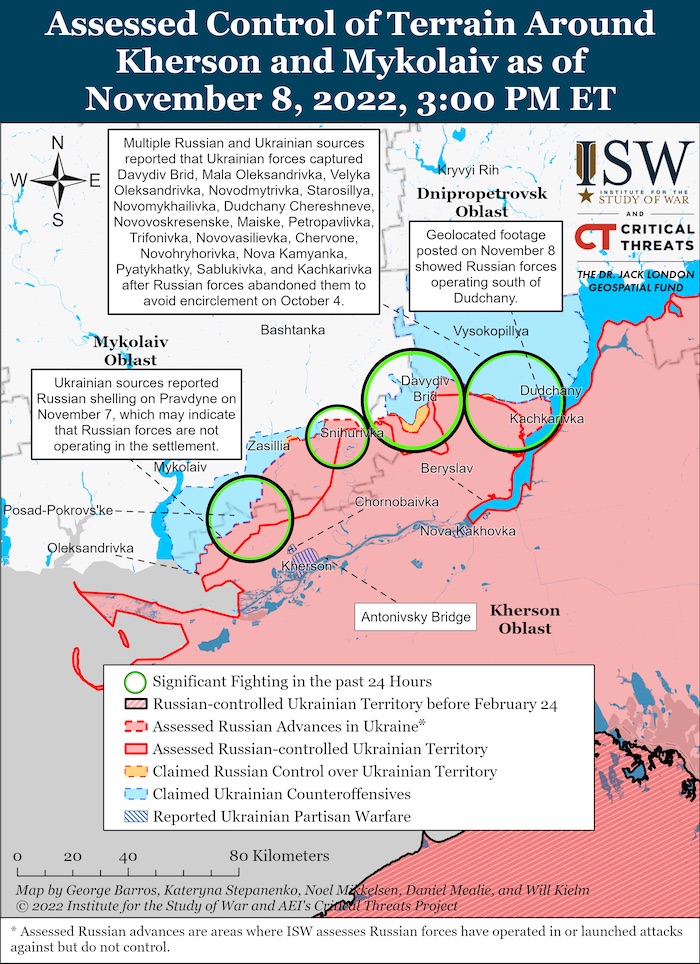
Military Updates
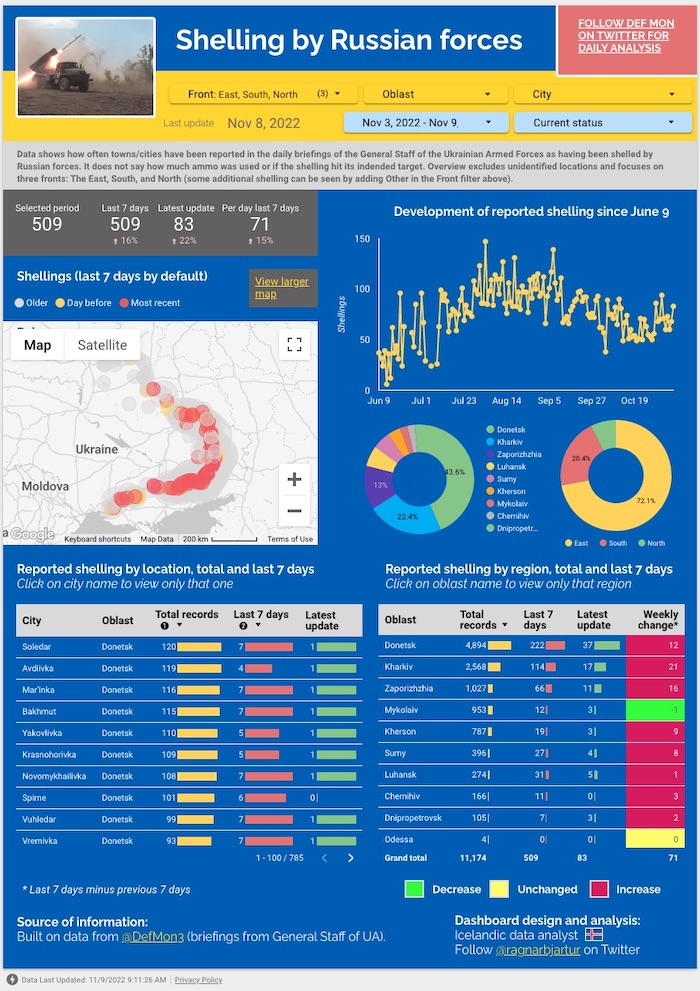
Russia is preparing a multi-layered defense on the east bank of the Dnipro in occupied Kherson Obl, satellite images analyzed by @coupsure show
Fortifications are similar to Nazi Germany’s “Atlantic Wall,” built to prevent a landing of Allies during WWII https://t.co/4Bcx9k7vBp pic.twitter.com/QHIPKBNZnA
— Euromaidan Press (@EuromaidanPress) November 8, 2022
Russia is preparing a multi-layered defense on the east bank of the Dnipro river in the southern Kherson Oblast, analysis of satellite images and intelligence reports show. OSINT-analyst Benjamin Pittet in collaboration with other Twitter analysts analyzed in detail the area of Ukraine’s south. Satellite images that he published reveal defense lines not only on the east bank near the crucial city of Kherson but also on the Black Sea and on the entire east bank of the Dnipro River.
These fortifications are similar to Nazi Germany’s “Atlantic Wall,” built to prevent a landing of the Allies during WWII; three lines of defense are being created, the defense portal Defense Express notes:
- along the east bank of the Dnipro River
- 5-10 km from the Dnipro
- 20-25 km from the Dnipro
This is all being done without any advertisement which accompanies the construction of the so-called “Wagner line,” a series of anti-tank fortifications made of concrete pyramids that extend into Russia’s Belgorod Oblast. The length of the defense lines is about 180-200 km, which requires quite significant efforts and costs for its creation.
If Russia is undertaking similar efforts to build defensive structures along the frontline in Zaporizhzhia Oblast leading to Donbas, this likely means that the Kremlin’s offensive potential is largely depleted and it is transitioning to controlling the already-occupied territories, with the goal of preserving its land bridge to Crimea, Defense Express suggests. Read more here.
According to British Defence Intelligence, (last 48 hours):
https://twitter.com/DefenceHQ/status/1590295039342628865
- Russian efforts to repair the Crimean Bridge continue but it is unlikely to be fully operational until at least September 2023. On 8 November the road bridge was due to be closed to allow the movement and installation of a replacement 64-metre span. Three more spans will be required to replace the damaged road sections.
- Although Crimean officials have claimed these additional spans will be in place by 20 December, a briefing provided to President Putin added that works to the other carriageway would cause disruption to road traffic until March 2023.
- Replacement of the damaged rail bridge has been contracted for completion by September 2023, although Russia’s Deputy Prime Minister stated the repair timeline would be expedited. One track is open, but rail transport remains restricted. Repair activity will be heavily dependent on weather conditions through the winter months.
- The Crimean bridge attack has disrupted Russian logistics supplies for Crimea and southern Ukraine, reducing Russia’s ability to move military equipment and troops into the area by rail or road.
Losses of the Russian army
As of 9 November, the approximate losses of weapons and military equipment of the Russian Armed Forces from the beginning of the war to the present day:
These are the indicative estimates of Russia’s combat losses as of Nov. 8, according to the Armed Forces of Ukraine. pic.twitter.com/RMcV48kdZq
— The Kyiv Independent (@KyivIndependent) November 8, 2022
Humanitarian
#Russia destroys or damages over 1100 #hospitals in #Ukraine and plunders others#StandWithUkraine #RussiaWarCrimes #StopRussia #RussiaTerroristStatehttps://t.co/9XU5S3BQm7 pic.twitter.com/BX4in6qCaH
— Halya Coynash (@halyapuff) November 9, 2022
90 years ago, the Russians already used hunger as a weapon in Ukraine, said the head of the Presidential Office Andriy Yermak. Yermak held the first meeting of the working group to develop proposals for helping countries suffering from an acute food crisis. He stressed that the food crisis is the result of Russian aggression against Ukraine.
Environment
Due to warm autumn, Ukraine started taking gas from storage later than usual which will help go through winter.
Turkey has started paying for Russian gas partially in rubles currency - Energy Minister of Turkey
In September, Ankara and Moscow agreed on the beginning of ruble payments for the supply of natural gas.https://t.co/AEoK2CJwQ0
— Euromaidan Press (@EuromaidanPress) November 9, 2022
British Prime Minister Rishi Sunak is preparing to announce a major gas deal with the United States, The Telegraph reported. Talks on an “energy security partnership” are in their final stages, with the US planning to sell Britain billions of cubic meters of liquefied natural gas over the next year. Read more here.
Ukraine's state company has started a new gas well in Kharkiv Oblast, the second during the invasion to stabilize the energy front
The capacity of the well is 140,000 cubic meters per day which is one step closer to full energy security of Ukraine. https://t.co/phTPbmTteA
— Euromaidan Press (@EuromaidanPress) November 8, 2022
️Legal
Heart attack proves #Russia is killing 60-year-old #CrimeanTatar political prisoner #FreeDzhemilGafarov #LetMyPeopleGo #Ukraine #StandWithUkraine #StopRussiahttps://t.co/rlOVDD4SrY pic.twitter.com/glvtcNhuTe
— Halya Coynash (@halyapuff) November 8, 2022
Russia's full-scale invasion of Ukraine has killed at least 6,490 civilians and injured 9,972, UN High Commissioner for Human Rights confirmed. 2,533 men, 1,731 women, 201 boys and 168 girls were killed. At the same time, the gender of 34 children and 1828 adults has not yet been determined. “The majority of recorded civilian deaths or injuries were caused by the use of explosive weapons with a large area of effect, including shelling from heavy artillery and multiple rocket launchers, as well as rocket and air strikes,” the UN data document says.
Ukraine to submit a draft resolution to UN to force Russia to pay reparations, according to The New Voice of Ukraine. According to the publication, the document will be submitted to the UN General Assembly in November, but this will only be the beginning of a long process that will end with the payment of reparations. However, diplomats emphasize that payments will not begin soon. Sources in the UN told reporters that the draft resolution will be presented to the General Assembly in the coming weeks. After its adoption, the parliaments of the countries in which the arrested assets of the Russian Federation are located will be able to start discussions the process.
Support
French President Emmanuel Macron supports holding peace talks between Ukraine and Russia on Kyiv’s terms at a time convenient for Ukraine, Macron said
during a press conference in Egypt at the COP27 summit. Read more here.
The EU will propose on Wednesday a new mechanism to provide €18bn in financial aid to Ukraine in a more predictable manner for 2023 but Hungarian approval may be a problem
The EU still needs to approve the remaining €3bn of a promised €9bn 2022 package https://t.co/wNUicS9wXV
— Euromaidan Press (@EuromaidanPress) November 9, 2022
The Pentagon confirmed the transfer of two NASAMS air defense systems to Ukraine. The Armed Forces of Ukraine are already using two NASAMS air defense systems transferred to them by the United States. Training of personnel took place in Europe, a Pentagon representative said at a briefing, refusing to clarify whether the delivery of ATACMS tactical missiles is possible.
Italy is open to transferring SAMP/T and Aspide air defense systems to Ukraine. A spokesman for the Italian government coalition confirmed that his country is ready to begin deliveries of various air defense systems, including the Franco-Italian SAMP/T medium-range air defense systems and the Italian Aspide, as well as man-portable Stinger missiles, to Ukraine. Information about the number of systems that Italy can transfer, and the date of their delivery TBC.
New Developments
Zelenskyy will take part in the G20 leaders’ summit in Bali, Indonesia likely in an online format, presidential spokesman Serhii Nikiforov said in a comment to “Suspilne". Read more here. Putin may join G20 summit virtually.
Putin may join G20 summit virtually - Reuters
According to the President of Indonesia, Joko Widodo, Putin will participate in the G20 summit "if it is possible."https://t.co/1AZjB83iKy
— Euromaidan Press (@EuromaidanPress) November 8, 2022
Zelenskyy orders study on extending diplomatic recognition to Chechnya-Ichkeria. Zelenskyy has directed his foreign ministry to study the question, noting that he alone has the power to decide whether to extend recognition or not. Zelenskyy’s response came on the Ukrainian government portal dealing with petitions to him and by itself does not mean that he is about to recognize Chechnya-Ichkeria or that republic’s government in exile. But it is an indication that Kyiv’s earlier move in declaring that republic temporarily occupied is unlikely to be the last.
Ukraine plans to mobilize 300,000 mosquitoes in the project "Mosquitoes against Moscowitoes"
Ukraine's Minister of Defense mocked Russian representative in the UN Security Council who accused Ukraine of plans to use combat mosquitoes https://t.co/FODeHehgGh
— Euromaidan Press (@EuromaidanPress) November 8, 2022
The United States will not force Ukraine to negotiate with Russia, stated the US Ambassador to the UN Linda Thomas-Greenfield. “We have made it very clear: no negotiations in which Ukraine is not in the driver's seat. Any negotiations should take place with the participation of Ukraine. Ukrainians must decide when they are ready for these negotiations,” the diplomat said. According to her, the support of the United States will continue until Ukraine wins this war and until Russia withdraws its troops.
Germany will provide Ukraine with 7.6 million euros to help find missing people, according to German Embassy in Ukraine.
Russia says it is ready for negotiations with Ukraine without preconditions. "There are no preconditions from our side, except for the main condition: that Ukraine shows goodwill," Deputy Foreign Minister Rudenko said.
Assessment
- On the war.
The Institute for the Study of War has made the following assessment as of 8 November, 2022:
Iranian state-run outlet Nour News Agency reported that Russian National Security Council Secretary Nikolai Patrushev arrived in Tehran on November 8, likely to discuss the potential sale of Iranian ballistic missiles to Russia.[1] Nour News Agency announced Patrushev’s arrival in an English-language tweet, stating that Iranian Supreme National Security Council (SNSC) Secretary Ali Shamkhani invited Patrushev and noted that Patrushev will also meet with other high-ranking Iranian political and economic officials to discuss Russo-Iranian cooperation.[2] Nour News Agency is affiliated with the SNSC. The SNSC likely announced Patrushev’s arrival in Iran to highlight the deepening cooperation between Moscow and Tehran to an international audience (rather than domestically), as well as to implicitly highlight that a high-ranking Russian official turned to Iran for help in Ukraine. Islamic Revolutionary Guards Corps (IRGC) Quds Force Commander Qassem Soleimani notably traveled to Moscow in 2015 to appeal to Russia to intervene in the Syrian Civil War. Tehran is likely eager to publicly signal this rebalancing of its strategic partnership with Moscow, especially to regional Iranian adversaries with which the Kremlin occasionally cooperates, such as Israel and Saudi Arabia.[3] Patrushev’s visit to Iran notably comes amid reports that the Iranian regime is seeking Russian help with protest suppression, although it is unclear if this will be discussed by Patrushev and his Iranian counterpart.[4]
The Kremlin is continuing efforts to covertly acquire munitions for use in Ukraine to mitigate the effects of international sanctions and backfill Russia’s ongoing depletion of domestic munitions stockpiles. British outlet Sky News reported on November 8 that the Kremlin flew 140 million euros in cash and a selection of captured British-made NLAW anti-tank missiles, US-made Javelin anti-tank missiles, and a Stinger anti-aircraft missile to Tehran on August 20 in exchange for 160 additional Shahed-136 drones for use in Ukraine.[5] The Ukrainian Resistance Center reported on November 8 that Tehran continues to supply Moscow with Mohajer, Arash, and Shahed-type drones by air and sea via both Iranian state-owned and privately-owned entities.[6] The Ukrainian Resistance Center additionally reported that due to failures of the Russian military-industrial complex, Russian military leaders are continuing their efforts to procure dual-use (military and non-military use) goods such as computer chips, quadcopters, night vision devices, and bulletproof vests from Türkiye and are using cryptocurrency transactions to avoid purchase tracking.[7] Taken in tandem, these reports indicate that the Kremlin seeks to circumvent sanctions by engaging in quid-pro-quo and under-the-table negotiations with foreign actors.
Wagner Group forces are continuing to exaggerate their claimed territorial gains in Donbas to further distinguish themselves from proxy and conventional Russian forces. Russian sources began reporting on November 7 that a detachment of Wagner forces and troops of the Luhansk People’s Republic (LNR) 6th Cossack Regiment broke through Ukrainian defensive lines in Bilohorivka, Luhansk Oblast.[8] On November 8, however, Russian coverage largely shifted and Russian milbloggers began claiming that reports of the 6th Cossack Regiment’s involvement in operations near Bilohorivka are false and that Wagner troops were solely responsible for purported gains.[9] As ISW has previously observed, Wagner has taken sole credit for Russian gains around Bakhmut in order to bolster their own reputation as the Kremlin’s favored strike force, despite not being the only force deployed in the area.[10] Wagner will likely use Bilohorivka to accomplish a similar effect.
Key Takeaways
- Iranian sources announced—without Russian confirmation—that Russian National Security Council Secretary Nikolai Patrushev arrived in Tehran on November 8, likely to discuss the potential sale of Iranian ballistic missiles to Russia. Iran likely announced Patrushev’s arrival to highlight the deepening cooperation between Moscow and Tehran to an international audience, as well as to implicitly highlight that a high-ranking Russian official turned to Iran for help in Ukraine.
- Wagner Group forces are continuing to exaggerate their claimed territorial gains in Donbas to further distinguish themselves from proxy and conventional Russian forces.
- Ukrainian forces likely made marginal gains northwest of Svatove, Luhansk Oblast, and Russian sources claimed that Ukrainian forces intensified offensive operations toward Kreminna.
- Russian forces continued offensive operations around Bakhmut, Avdiivka, and in western Donetsk Oblast.
- Ukrainian authorities attempted to counteract Russian authorities’ continued efforts to strengthen control of the Zaporizhzhia Nuclear Power Plant (ZNPP).
- The disproportionate financial burden of Russian force generation efforts continues to fall primarily on Russian regional governments’ budgets, prompting public backlash.
- Financial and bureaucratic issues are continuing to hinder Russian efforts to replenish formerly elite units defending critical areas of the front line, potentially threatening the integrity of Russian defenses in occupied parts of Ukraine.
- Russian occupation authorities in Kherson Oblast may be trying to force residents out of the western part of the oblast by cutting communications on the west bank of the Dnipro River.



